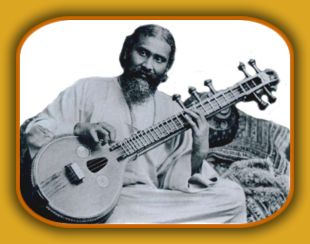|
On
July 5th, 1882, in Baroda, India, a child named
Inayat was born into one of the most musical families in the country.
Inayat's grandfather, Maula Bakhsh, known as the 'Beethoven of India,'
had become a master of the music of both North and South India, a feat
hitherto considered impossible, and had then, at the invitation of the
Maharaja Khanda Rao, settled in Baroda where he founded 'Gayanshala,'
the first musical academy of its kind in India. Maula Bakhsh drew about
him many people of culture and refinement. Among his students and associates
was Rahmat Khan, who came from a family of musicians, poets and mystics.
Rahmat married Khatidja, the second daughter of Maula Bakhsh, and their
first child was Inayat.
Inayat quickly showed great musical talent, and before he was twenty
he was singing and playing the vina in the courts of royalty all over
the subcontinent. Indeed, from a set of recordings Inayat made
at the age of 27, modern musicologists are able to say that his vocal
skill and musical understanding remain unequalled to this day. Called
to something beyond worldly success, however, he at last met his Murshid,
Abu Haimages/shim Sayed Madani and entered the Sufi path.
On September 13th, 1910, destiny brought Inayat "from the world of
lyric and poetry to the world of industry and commerce," sailing from
Bombay first to America, and travelling thence to Europe. In this he was
fulfilling the last words of his Murshid, "Fare forth into the world,
my child, and harmonize the East and West with the harmony of thy music.
Spread the wisdom of Sufism abroad, for to this end art thou gifted by
Allah, the most Merciful and Compassionate." Companions
on that journey were his brothers Maheboob Khan
and Ali Khan, who left auspicious careers
in India to share his hardships and his work. Within a year they were
joined by Inayat's youngest brother, Musharaff
Khan.
During the next sixteen years, Inayat founded the International Sufi
Movement and travelled widely, inspiring many and teaching the Sufi Message
from California to Moscow. In America, he met the woman destined to become
his wife and companion, Ora Ray Baker.
Their first child was born in Russia, and the remaining three in England,
where they sheltered during the First World War.
In the early 1920's, the family settled in Suresnes, a quiet suburb
of Paris, and here Summer Schools were held for the growing number of
students. The lectures given here and elsewhere have subsequently been
published under such titles as "The Unity of Religious Ideals," "In an
Eastern Rose Garden," "The Mysticism of Sound," "Love, Human and Divine,"
and "Health, Mental Purification and the Mind World."
In 1926, Inayat returned for a visit to India, leaving his family
in the West. After a brief illness, he passed away in Tilak Lodge, New
Delhi on February 5th, 1927, at the age of 44. His Dargah
or tomb, located near that of Hazrat Nizamuddin Auliya, is now a place
of pilgrimage for Sufis from all over the world.

|


